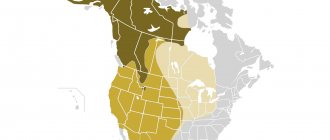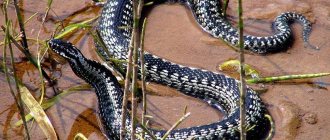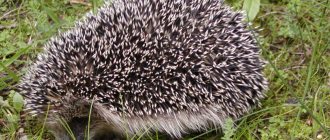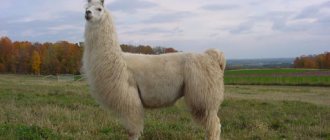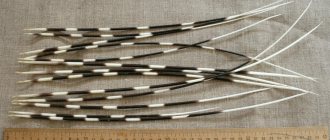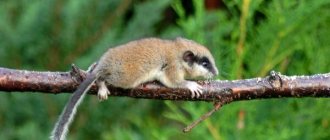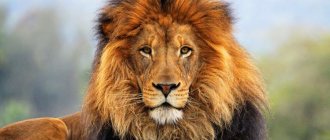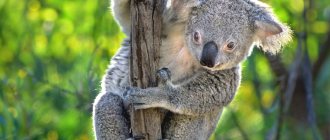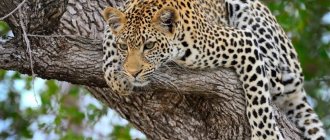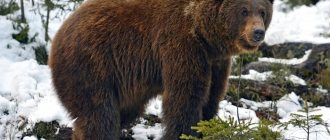The sea otter is a predatory marine mammal of the mustelid family, a species close to otters.
The sea otter has a number of unique features of adaptation to the marine environment, and is also one of the few non-primate animals that use tools. Sea otters live on the northern shores of the Pacific Ocean in Russia, Japan, the USA and Canada. In the 18th-19th centuries, sea otters were subjected to predatory extermination because of their valuable fur, as a result of which the species was on the verge of extinction. In the 20th century, sea otters were listed in the Red Book of the USSR, as well as in the protection documents of other countries. As of 2009, hunting sea otters is virtually prohibited in all regions of the world. Only the indigenous population of Alaska, the Aleuts, are allowed to hunt sea otters, and exclusively to support the folk crafts and food diet that have historically developed in this region.
Description of the species
The appearance of the sea otter indicates the adaptability of this animal to life in water. Its body is elongated and very flexible, its head is relatively small, its ears are small, buried in fur, but its whiskers (“whiskers”) are long and hard. Hearing and vision are not very well developed in these animals, but their sense of smell and touch are excellent. The eyes of sea otters are designed in such a way that they better see objects under them, rather than around them. But even with complete loss of vision, a sea otter can successfully hunt, guided by smell and tactile sensations.
The front paws of sea otters are armed with small but tenacious fingers, and the hind paws have swimming membranes. The tail is of medium length. The kidneys of these animals are capable of excreting large amounts of salts, so they can even drink sea water. The lungs are also significant. The air contained in them gives sea otters buoyancy, so they do not drown, even while remaining completely motionless on the water. But they have no subcutaneous fat at all; only wool provides protection from the cold.
Sea otter fur is very similar in properties to otter fur. It is short, very thick and warm. Due to the high density of the pile, the fur practically does not allow water to pass to the skin, although the outside gets wet. The thermal insulating properties of fur are enhanced by fatty grease. The skin of sea otters has another unusual property. The size of the skin significantly exceeds the size of the animal’s body, so numerous folds form on the sea otter’s skin. Under the armpits of the front paws, the folds form real pockets in which the animals hide their prey. Sea otters lack sexual dimorphism, males and females look the same, males are only slightly larger. The coloring of these animals is brown, the fur on the head is lighter and often looks almost gray. The size of the sea otter is very impressive: it reaches 1.3-1.4 m in length (the tail is 30-36 cm), and weighs 20-45 kg.
The front and hind legs differ in structure: the hind legs look like furry flippers, and the front ones vaguely resemble those of a dog, only the toes are not separated, but seem to be glued to each other. Another important element in the appearance of a sea otter is the tail, thanks to which the animal moves in the water and controls the direction of movement while swimming. The tail is small in size, however, very thick and strong.
What does a sea otter eat?
Photo: Otter sea otter
Sea otters consume more than 100 types of prey. They spend a lot of energy maintaining a body temperature of 38 °C. Therefore, they need to eat 22-25% of their body weight in food. The animal's metabolism is 8 times higher than that of land-breeds of similar size.
Their diet mainly consists of:
- sea urchins;
- shellfish;
- mussels;
- snails;
- crustaceans;
- sea stars;
- tunicates, etc.
Otters also eat crabs, octopus, squid and fish. As a rule, the menu depends on the habitat. They get most of their fluids from prey, but also drink seawater to quench their thirst. In studies in the 1960s, when the sea otter population was under threat, 50% of the food found in sea otter stomachs was fish. However, in places with plenty of other food, fish formed a small part of the diet.
Sea otters feed in small groups. Hunting takes place on the seabed. They use their sensitive whiskers to locate small creatures in dense kelp forests and crevices. The animals use mobile front paws to capture prey and place invertebrates in the loose folds of their skin under their armpits, feeding on them on the surface. Sea otters usually eat 3-4 times a day.
California sea otters break their prey with hard objects. Some otters hold a stone on their chest and knock their prey against the stone. Others hit their prey with a stone. One stone is saved for many dives. Sea otters often wash their prey by holding it close to their body and turning it in the water. Males steal food from females if they have the chance. For this reason, females feed in separate places.
History of discovery
When in 1741 the expedition of Vitus Bering crashed off the uninhabited islands, later called the Commander Islands, interesting animals of quite large size, with a strange appearance, which covered the coastal rocks in abundance and swam in the surrounding waters, appeared before the eyes of the team. The animals were not at all afraid of people, they allowed them to come almost close and, driven by curiosity, they swam up to the aliens’ boats and came to the fires of the sailors in trouble. These were sea otters, which were later introduced to the world as a sea beaver by the expedition naturalist Georg Steller.
Fishing
Because of its valuable fur, the sea otter almost disappeared as a species from the face of the Earth. Immediately after Bering’s expedition in the mid-18th century, the Commanders, the Aleutian Islands and Alaska were full of seekers of happiness - “soft gold”. During the period from 1798 to 1845, the Russian-American Company sold 118,000 sea otter skins, and by 1867, the Russians exported 260,790 skins from Russian America. The Americans killed 90,000 sea otters in Alaska from 1871 to 1890, and in the next 10 years only 6,143 sea otters. In general, by the 20th century, sea beaver fishing in Russia and America had completely ceased. By this time, the global sea otter population had fallen from the 300,000 sea otter population in the 18th century to several thousand by 1911, when the fishery was ended by an International Convention signed by Russia, America, Japan and England (for Canada).
At first, they were hunted only on the more accessible Bering Island, and later, when the number of sea otters here catastrophically decreased, fishers reached Medny Island. And only the harsh sailing conditions off the rocky coast of Komandor, frequent storms and the lack of good anchorages saved the sea otters from complete extermination. By 1924, when the strictest ban on fishing for this sea animal was issued, only a few dozen of them remained, and then only on Medny Island.
Mass extermination and conservation of sea otters
The mass extermination of sea otters, which continued from the mid-17th century, turned the animal’s continuous habitat into small isolated areas by the beginning of the 20th century, mainly in areas extremely inaccessible to humans. According to various estimates, before the start of mass extermination, from several hundred thousand to a million sea otters lived in the world, but by the beginning of the 20th century there were only about 2,000 individuals in the world. Currently, due to the widespread ban on hunting sea otters, their numbers have increased significantly - there are about 88 thousand sea otters in the world, which is less than 20% of their number in the mid-18th century, but their habitat remains intermittent.
In 1911, when it became obvious to all participants in the “great hunt” that the situation of sea otters had become catastrophic, the first international agreement to ban sea otter hunting (Fur Seal Treaty) was finally signed. In 1913, the first reserve was created to protect the habitat of the sea otter (in the USA in the Aleutian Islands). The USSR banned sea otter hunting in 1926, and Japan finally banned it in 1946. In 1972, the International Marine Mammal Conservation Act was adopted, which further strengthened international law on this issue. Hunting of sea otters was thus prohibited in all regions of the world. Thanks to the measures taken, since the mid-20th century, the sea otter population has increased annually by 15%, reaching about a fifth of its original size by 1990. Between 1990 and 2007, there was virtually no population growth.
Experiments
Research conducted in Russia and the United States shows that in order for sea otters to thrive, their habitat must have certain characteristics. In particular, it should be quite wild, located far from human settlements, protected from winds and high waves, and difficult to access both from the water and from the shore. An extended zone of shallow water with thickets of seaweed is required, which provides shelter and food for bottom-dwelling marine invertebrates, creating the basis for the development of a good food supply. And finally, the presence of shelters is required in which sea otters could hide from both predators and bad weather.
Studies of sea otter populations on Medny and Bering Islands have shown: despite the fact that Bering Island has a larger coastal shallow water zone, the population density here is lower than on Medny Island, since there are not many truly good habitats on Bering Island that would have all the listed characteristics. In particular, Bering Island is dominated by open bays that are frequented by people and polar foxes; there are few refuges here. On Medny, on the contrary, the bays are mostly closed and there are more places where sea otters can feel safe.
Here's another example. In California, in 1986, an extended “no otter zone” was created - fashionable sections of the coast of San Diego, Los Angeles, Santa Barbara), from which the animals began to be resettled on the lonely island of San Nicolas in the ocean. . As they say, no sea otter - no problem, no need to limit development and fishing, no conflicts with environmentalists. In 1986–1987, 140 sea otters were transported from the coast to the island, but only 11 (8%) took root. Now, 20 years after settlement, the population on the island numbers 32 sea otters. A completely different dynamic was observed in Glacier Bay in Alaska, where living conditions for sea otters turned out to be very favorable. In 1995, the first 5 sea otters swam here, and by 2001 there were more than one and a half thousand of them, thanks to both offspring and new arrivals. However, there are fewer and fewer such wonderful places left, and even in nature reserves the peace of sea otters is not always guaranteed: despite the prohibitions, they are shot at, they die under the propellers of motor boats and in fishermen’s nets. Therefore, where sea otters are closely adjacent to humans, their numbers will most likely continue to decline, unless, of course, some special measures are taken to protect their habitat.
Video
Habitat
These animals live in the coastal waters of the North Pacific Ocean. Their range covers the coasts of the Aleutian and Commander Islands, Kamchatka, Alaska and California. Usually sea otters are located at a distance of 10-80 m from the shore; in calm conditions they can move away from land several kilometers deep into the ocean. In general, they lead a sedentary lifestyle, although they do not have permanent areas and do not protect their territory. Places where sea otters gather are random; they arise spontaneously in shallow waters rich in food, protected from attacks by predators.
Sea otters spend most of their lives in the water and only climb out onto coastal cliffs or rocky shores to rest. They do not form large rookeries, like fur seals.
The sea otter is a purely diurnal animal. At night it usually sleeps on the shore (near the shore), and at dawn it goes out to sea, moving to feed no further than 25 km from the coast. Sometimes sea otters roost for the night among thickets of seaweed, the thickets of which serve as a reliable natural breakwater that dampens the waves rolling in from the ocean. Having dived under an almost continuous carpet of algae, the sea otters spin around, wrapping ribbons of seaweed around themselves so that they find themselves swaddled, after which, turning on their backs and putting their heads and bellies out of the water, the animals sleep.
Population and species status
Photo: Animal sea otter
The sea otter population is thought to range from 155,000 to 300,000 individuals and extends in an arc across the North Pacific Ocean from northern Japan to the central Baja California peninsula in Mexico. The fur trade, which began in the 1740s, reduced sea otter numbers to approximately 1,000 to 2,000 in 13 small colonies.
Hunting records researched by historian Adele Ogden place the westernmost limit of the hunting grounds off the northern Japanese island of Hokkaido and the easternmost limit at about 21.5 miles south of California's westernmost cape in Mexico.
In approximately ⅔ of its former range, the species is in varying levels of recovery, with high population densities in some areas and endangered populations in others. Currently, sea otters have stable populations in parts of the east coast of Russia, Alaska, British Columbia, Washington and California, with recolonization in Mexico and Japan. Estimates of the number of individuals made between 2004 and 2007 show a total of about 107,000 individuals.
Sea otters are important to the overall health and diversity of the kelp ecosystem. They are considered keystone species and play a critical role in the community by controlling invertebrate herbivory. Sea otters prey on sea urchins, thereby preventing their overgrazing.
Nutrition
In the afternoon, after feeding, sea otters go ashore to rest and sleep: with their short front legs, with rough pads instead of fingers, they first clean their eyes and whiskers, then their skin. Thick, soft, silky fur requires careful care; it is cleaned of algae scraps, then thoroughly smoothed. Then sleep continues for two or three hours, the sea otter sleeps very soundly and often gives the opportunity to come close to it on the shore or drive up in a boat. After a sound sleep, the animals doze for some time, opening their pink mouth with sharp teeth, stretching, turning over from side to side, yawning continuously, and when hungry they go back to the sea.
When getting food, the sea otter dives near the coastal rocks and collects urchins from the bottom or picks off clusters of mollusks from the stones. Having grabbed several hedgehogs with its front paws, it floats to the surface and lies on its back, placing its prey on its chest, in the folds of its skin. Having taken one of the hedgehogs, he twirls it with his front paws, breaking off and crushing the needles with his hard paw pads, without ever pricking himself, and then eats it. Having bitten through the shell of a hedgehog, the sea otter licks or scrapes out the contents with its paw, and throws away the remaining shell. After eating, the sea otter begins to scroll (spin) in the water, washing away any remaining food from its fur.
The sea otter is one of the few animals that can use tools. Large mussels, which serve as one of its main types of food, are covered with a black-violet, very durable shell, which is not easy to gnaw with teeth. For this purpose, the sea otter saves a fairly large stone (weighing up to 3.5 kg), previously selected at the bottom, and placing it on its belly, beats the mussel against the stone until the shell cracks. Having eaten, the sea otter does not throw away the stone, but again puts it “in its bosom” until the next meal.
Features of behavior
Sea otters are not too attached to any particular area and often leave it. In calm weather they feed in shallow places away from the coast, and in storms and winter they stay near the shore. The sea otter can stay in the sea for a long time without going ashore; it swims quickly (up to 12-16 km/h), frolics, and dives deeply. It swims by bending its whole body with motionless rear flippers.
Sea otters are skilled divers and can dive to several tens of meters (a maximum depth of 54 m has been recorded). They usually come to the surface to breathe every 50-90 seconds, but can remain underwater for up to 6 minutes.
On land, the sea otter moves with difficulty, dragging its belly along the ground and clumsily bending its body to the sides, slips on wet stones, and if the rock surface allows, it simply slides down on its belly. In the snow, the crawling body of a sea otter leaves a trace in the form of a rather deep groove, about 30 cm wide, along which the prints of the front and hind paws are clearly visible. Starting near the water, such a trail usually goes up the shore and ends in an oval bed, about a meter long and half a meter wide. The bed site is noticeable by heaps of feces, in which there are remains of shells of sea urchins and crabs, fragments of mollusk shells and fish bones. The track back to the sea is the same groove in the snow, but often without paw prints if the sea otter slides down without relying on its paws.
In case of sudden danger, the sea otter tries to move faster, arching its back and bringing its front and hind legs together. This way he can run a short distance and even make a few jumps.
Sea otters lead a solitary lifestyle most of the time. Females stay away from males, forming temporary pairs only during the mating season. During the mating season, male sea otters actively defend the territory they occupy, but contenting themselves with splashing their paws in the water and screaming when resolving territorial disputes, it rarely comes to a direct fight.
How do otters live?
Although many people consider otters to be nocturnal animals, they can easily lead an active lifestyle in the evening and even during the day if they believe that they are not in danger. Basically, these animals like to live alone, the only exception being females with children - young otters live with their mother for about a year and leave her only when she is about to reproduce again.
Despite the fact that otters spend almost all their time in the water, many of them feel good on land, along which they move at a trot, leaving a winding trail, and often make one and a half meter long jumps. But on loose snow, due to their short limbs, they move with difficulty, at a gallop, hunched over greatly. If the snow is more or less compacted, otters alternate jumping with sliding on their belly.
These animals are also very energetic and playful. Not far from their holes you can find “roller coasters” - hills with a compacted trail left by the animal sliding on its belly. The animal climbs this hill several times a day and slides down with a running start. Another favorite pastime is catching one’s own tail or hind leg, and often plays with the caught fish, after which it eats it.
In summer, when there is a lot of food in the reservoir, otters live in one place and do not move far from the site. The animal feeds on fish, frogs, crabs, and also catches rodents and even birds. The otter's hunting grounds at this time of year range from 2 to 18 kilometers along the river and 100 meters inland from the shore. In winter, if the fish leave or the ice freezes, thereby making hunting difficult, the animal is quite capable of covering 15 to 20 kilometers in a day in search of food.
Reproduction
Males are bachelors, and outside the breeding season, all sea otters often gather in groups to rest. Sea otters form small aggregations when roosting both at sea and on the shore.
Males flirt with females who inhabit their territory or themselves look for females in a state of estrus, which lasts about three days. Mating games continue for quite a long time: at the beginning of courtship, the female seems to be trying to get away from the male, swims quickly and often dives. Males chase females, grab them by the skin of the back of the head with their teeth and try to drag them onto themselves. Some of the females snap back, although quite good-naturedly, while others eagerly respond to advances. Mating occurs in water. After mating, the pairs do not separate - they spin in the water next to each other in order to mate again after a short time.
Females reach sexual maturity at 4 years, males at 5 years, but, as a rule, mate much later. In sea otters there is a delay in the development of embryos, which determines the duration of the gestation period from 4 to 12 months. Sea otters retain their ability to reproduce until old age.
Childbirth occurs on the shore or coastal rocks. Before giving birth, the female decisively goes ashore and settles down on a rock for a long time. The orientation of the embryo is either caudal or cephalic, although cephalic orientation is more common at birth. A single calf is born weighing 1.4-2.3 kg. Twins occur in about 2% of births, but only one young can be raised, although the female has two teats. After giving birth, the mother licks her baby for about an hour and then takes him out to sea.
Small sea otters stay with their mother for a very long time, who carefully looks after them for up to 7–8 months. Swimming on her back, the female holds the baby on her chest, lifting or turning it with her front paws, caressing and licking it with her tongue. Cubs feed on mother's milk for a long time, but begin to eat solid food soon after birth. While the mother dives to the bottom for food, the calf will remain on the surface; it begins to dive into the water after two months.
One-year-old sea otters sometimes feel quite independent, but more often they prefer to be under parental care, often even after the birth of a new calf. Many sea otters die at a young age; in general, the mortality rate among sea otters is very high.
Breeding time is not confined to a specific season, so mating can be observed throughout the year, but mainly in the spring - from March to May. Birth rates peak in June-May in the Aleutians and in January-March on the American coast.
In their habitats, sea otters, known lovers of sea urchins, literally influence the appearance of coastal underwater landscapes. After all, if the number of sea otters falls, then the vast “forests” of brown algae rich in living creatures disappear, since urchins - the main consumers of algae - begin to multiply quickly and soon reduce the bottom vegetation to nothing.
Social structure and lifestyle
Sea otter with calf
Both when hunting and when resting, sea otters gather in groups. When not hunting, sea otters are on land. At the same time, males and females rest separately. You can distinguish them by the sounds they make. Females usually grumble, but males can even grunt like piglets. Baby sea otters scream like seagulls. If these animals are frightened, they may whistle, hiss, or even scream loudly. But mostly animals lead a solitary lifestyle.
A sea otter underwater can reach speeds of up to 9 kilometers per hour. This is a high speed with which a predator can easily catch up with a fish. Typically, these animals can spend up to one and a half minutes hunting under water. But there are eyewitnesses who claim that the sea otter was underwater for about 6 minutes!
They sleep with clothes on their backs. To prevent them from being carried away by the current, sea otters wrap themselves in algae. Sea otters take great care of their fur. After all, the life of a sea otter depends on the strength of its skin.
Fur
Sea otter fur, exceptionally beautiful, soft, silky, and also very durable and wearable, is one of the most expensive in the world. He glorified the beast throughout the world - and almost destroyed it. “Just as the sable little by little brought the Russians to Kamchatka, so the even more expensive Kamchatka beaver (sea otter) led them further through the entire series of Aleutian Islands to the opposite continent, America,” - this observation by the 19th century naturalist Georg Hartwig noted the outstanding role of the sea otter in the development of Russian America. Precious fur lured Russian entrepreneurs to the East - to the lands discovered in 1741 by the Second Kamchatka Expedition. “The rumor about the riches of this newly discovered country,” wrote the historian Vasily Berkh, “aroused the enterprising spirit of the Siberian merchants, and the stories of Bering’s and Chirikov’s companions ignited an even stronger desire to enrich themselves with beaver pelts.”
In contrast to the “soft junk” (sable) mined in Siberia, which was taken for sale mainly in Europe, sea otter fur, which was held in high esteem by Chinese nobles, was sent to Kyakhta - the main point of trade between Russian merchants and the Chinese, where skins were exchanged for overseas goods, most often for tea. So it is no coincidence that it is believed that sea beaver fur contributed to the spread of tea drinking in Russia and the strengthening of business ties with China.
Lutra and man
Unfortunately, in the wild these predators are found less and less often, and therefore almost all of them are listed in the Red Book. An important role in this was played by the reduction of forests, which disrupted the hydrological regime, active fishing, which reduces the amount of food, and pollution of rivers, lakes, seas, oceans and other bodies of water on our planet. The animal suffered greatly due to its extremely warm, thick and soft fur - in some places they were almost completely exterminated by poachers.
https://youtube.com/watch?v=_frMKBO71ao
To save this subspecies, zoologists often raise otters in artificial conditions, and when the animals reach a certain age, they are released into the wild. Some people even try to keep an otter in their home. Although these animals are extremely intelligent and easy to tame, keeping an otter as a pet is not the best option: keeping one is not easy, especially if you do not live in a mansion that does not have a pool or pond near it. A bath is not particularly suitable in this case, since the animal bathes often, after which it rolls on the floor to dry its fur (it prefers carpets)
Enemies
In the Aleutian Islands, the sea otter population declined catastrophically in the 1990s. American researchers suspect migratory killer whales are responsible for this: previously, the basis of their diet was large cetaceans, the reserves of which were undermined by whaling. And then the killer whales began to successively switch to feeding on seals, fur seals, sea lions, until the turn came to the smallest marine mammals - sea otters.
According to calculations, one killer whale can eat 1,825 sea otters in a year, and the disappearance of 40 thousand individuals from the islands over six years of observation could be a consequence of the predation of only four (3.7, to be exact) killer whales. The very fact of increased attacks by killer whales on seals and sea otters is beyond doubt. Why then does this species thrive on the neighboring Commander Islands? According to Kamchatka biologist Alexander Burdin, on the Commanders, migratory killer whales prefer to hunt more abundant and accessible fur seals, which serve as a kind of shield for other possible prey species, including sea otters.
Where do sea otters live?
In the XVIII-XIX years there were quite a lot of sea otters, from several hundred thousand to several million. Animals lived along the entire northern Pacific coast. But due to mass destruction, by the twentieth century there were no more than 2000 of them left, in the Aleutian Islands. Due to such circumstances, it was decided to take sea otters under protection.
The ban on hunting has yielded positive results; the number of sea otters has increased. From 1950 to 1960, much effort was made to resettle sea otters into their former habitats. This attempt was only partially successful; the gaps between the areas remain quite large.
Nowadays, the sea otter's habitats remain off the coasts and coasts of California and Alaska, as well as in the far east of Russia. In addition, small populations are found on the island. Hokkaido, Japan. The largest population of sea otters lives off the coast of British Columbia (Canada) in Alaska and Washington state. The number near their shores is approximately 70 thousand individuals. In Russia, the largest number of sea otters, approximately 15 thousand, live on the shores of Medny Island, one of the Commander Islands in the Kamchatka Territory.
- Cross spider
- Reptiles
- 72 facts about plants
- Animals of Siberia
- 35 facts about giraffes
- Animals of Crimea
origin of name
The word “sea otter,” which entered the Russian language, is of Koryak origin: in Koryak, kalaga (kolakha) means “beast.” Before this, the Russian language usually used the name “sea beaver”, less often “Kamchatka beaver” or “sea otter”. Hunters of the North also used a number of specific terms: “medvedka” for newborn sea otters (up to 6 months), “koshlak” for one-year-old sea otters, as well as a number of names for sea otters, borrowed from the languages of the peoples of the North and the Kuril Islands, including the Aleutian “chnatokh”, Kamchadal “ keikoch" and "kakku", Kuril "kaiku", Ainu "trachka" and Japanese "rakko".
Thanks to the actions of the Russian-American company, which was engaged in sea otter fishing in the 18th-19th centuries and founded the Russian-Aleut settlement of Fort Ross in California for hunting California sea otters, the Koryak word “sea otter” also entered the English language (English kalan), but remained in use only until the end of the 19th century. Currently in English, as in many European languages, sea otters are called "sea otters".
The color of sea otters varies from almost red to almost black, with a predominance of dark brown individuals, however, certain parts of the body, especially the head, “grey” with the age of the individual. Occasionally, albinos are completely white, and even more rarely melanistic, that is, individuals who are completely black. In general, areas of a sea otter’s skin that are not subject to graying usually darken with age from reddish shades to dark brown and black, while areas subject to graying, especially the head, on the contrary, become lighter. Thus, in sea otters, color contrast increases with age. The researchers found no sex differences in the coloration of sea otters. In common sea otters (especially the so-called “Kamchatka sea otters”), “burning out” (reddening) of the hair is observed in the summer.
[edit] Literature
- Mammals of the Soviet Union, vol. 2, part 1, M., 1967.
- Great Soviet Encyclopedia. - M.: Soviet Encyclopedia. 1969-1978.
- Biological encyclopedic dictionary. Ch. ed. M. S. Gilyarov; Editorial team: A. A. Babaev, G. G. Vinberg, G. A. Zavarzin and others - 2nd ed., corrected - M.: Sov. Encyclopedia, 1986.
- Biology. Modern illustrated encyclopedia. Ch. ed. A. P. Gorkin; M.: Rosman, 2006.
- Encyclopedic Dictionary of F. A. Brockhaus and I. A. Efron. - St. Petersburg: Brockhaus-Efron. 1890-1907.
- Life of animals. Volume 6. Mammals or animals. Edited by S. P. Naumov and A. P. Kuzyakin. - M.: “Enlightenment”, 1971.
Captivity
Since the beginning of the 20th century, attempts have been made in the USSR to keep sea otters in captivity, mainly aimed at putting fur production on an industrial basis. The initial experiments of the thirties were unsuccessful: violations in the diet and failure to maintain clean water immediately led to various fatal diseases of animals - from various intestinal infections to pneumonia.
By the forties, scientists took into account the accumulated experience, and they managed to build an enclosure in such a way as to ensure the flow of sea water, as well as create the correct diet for the animal. From 1938 to 1941, several sea otters lived safely in such an enclosure, but with the beginning of the Great Patriotic War, the enclosure had to be closed and the sea otters released into the wild. At the same time, it became clear that maintaining sea otters in captivity requires significant effort and significant costs, and this called into question the economic efficiency of breeding animals.
Currently, sea otters are kept in captivity only for the purpose of study, as well as for display in a number of zoos (aquariums) in North America, Japan and Europe. In particular, the sea otter can be seen in aquariums in Seattle, Vancouver, Chicago, Newport, Monterey, New York, Lisbon, Osaka, Antwerp and other cities.
What animals and birds have become extinct recently?
Over the past 500 years, 844 species of animals and birds have become extinct. Let's remember some of them.
Dodos (Dodo)
These flightless birds lived in the Mascarene Islands and Mauritius. But the active colonization of these territories in the 17th century caused their rapid extinction. People not only hunted Dodos immensely, but also brought in some predators (rats, cats, dogs), which also contributed.
These birds received the name “Dodo” (from Portuguese - “stupid”) from sailors. The fact is that in their habitat they had no enemies and were trusting of people. There was no particular need to hunt Dodos - they simply approached them and hit them on the head with a stick. And it was difficult for these birds to hide from danger, because... they could neither fly, nor swim, nor run fast.
The coat of arms of Mauritius features the Dodo
Moa
The largest representative of one of the subspecies of these birds reached 3.5 meters and weighed about 250 kg. They didn't have wings. They lived in New Zealand until the 16th century, until they were completely exterminated by the aborigines.
Carolina parrot
This species was the only parrot that lived in North America. But this turned out to be unimportant and the Carolina parrot was exterminated, because... harmed fields and fruit trees. They were last seen in the 1920s.
Steller's cormorant
Another example when creatures unable to hide simply died from human onslaught. They flew poorly, or maybe they couldn’t fly at all. Therefore, hunting them was not difficult. Within 100 years of its discovery, the species had completely disappeared.
Tasmanian tiger
The last representative of this species died in 1936. It was the largest marsupial carnivore, living mainly on the island of Tasmania. Destroyed by humans due to damage to agriculture.
Bali tiger
The only place where these tigers lived was the island of Bali. With the advent of firearms there, local hunters began to take an interest in these cats, and within 25 years they destroyed the entire species.
Cameroon black rhinoceros
At one time, representatives of this subspecies of rhinoceros were distributed throughout almost all of Africa, but due to the efforts of poachers, by the early 2000s, only a few individuals remained. In 2011, the last representative of this species passed away.
Abingdon elephant tortoise
Lonesome George, the last of this species, died in 2012. These huge land turtles were inhabitants of the Galopogo Islands. Many of them lived to be 200 years old. Unfortunately, these turtles were killed by their proximity to people. Delicious meat and gorgeous shell - what hunter can resist this? It would seem that the ban on hunting was introduced in a timely manner, but poachers do not care about the laws...
Quagga
This unusual animal, resembling a hybrid of a zebra and a horse, was common in South Africa. They were trusting and friendly, so taming the quagga was not difficult. They were exterminated because of their tasty meat and valuable skins. The last representative of the species died in 1883.
Mexican grizzly bear
Declared extinct in 1964. Lived in North America until it was completely exterminated by local farmers, because... attacked livestock.
Be sure to watch the video, which tells about some more animals that became extinct due to our fault:
Role in ecology
Sea otters play a very important role in ocean ecology by controlling the number of sea urchins. The uncontrolled proliferation of these invertebrates leads to the destruction of seaweed, which in turn has a cascading, irreversible effect on the marine ecosystem. The successful experience of relocating sea otters to British Columbia (where they previously lived, but were exterminated) had a huge positive effect on the coastal ecosystem.
Sea otters maintain a peaceful relationship with most other marine mammals, including seals, ringed seals, seals, seals and sea lions. Although the sea otter emerges victorious even from a battle with fur seals, which are twice its weight and size, under normal natural conditions they do not conflict (hunters of the 18th-19th centuries cited numerous evidence of the victory of sea otters over seals if both species were caught together in hunting nets) . The real enemies of sea otters are three species of animals: the killer whale - the main hunter of sea otters, the polar shark and, in some areas, brown bears, and recently the polar shark has no longer been observed in the Pacific Ocean.
The main food competitor of the sea otter is the sealed seal; partial competitors are some species of seabirds and cod. Seagulls often act as “freeloaders” of sea otters, picking up shellfish they have caught and gutted, or the remains of sea urchins and crabs. Old and sick sea otters often come ashore, so the corpses of these animals often end up on the shore. Under natural conditions, arctic foxes and bears act as orderlies who eat dead sea otters.
Despite measures taken to stop the hunting of sea otters, the sea otter population has currently stopped increasing. The reason for this, according to scientists, is a number of environmental problems. The population density of people in the habitats of sea otters regularly increases, and the number of man-made risks increases.
Oil spills, usually caused by tanker accidents, pose an exceptional danger to sea otters. Even a very small amount of oil that gets into the water causes the guard hairs of sea otters’ fur to stick together, the lower down layer becomes wet, and the animals die from hypothermia. In addition, oil spills have many other negative consequences and cause food poisoning of sea otters and have a direct negative effect on the liver, kidneys, and eyes of animals.
For example, after the Exxon oil company tanker accident in 1989, the habitat of one of the largest colonies of northern sea otters—about 4,000 individuals—was contaminated off the coast of Alaska. About a thousand sea otters died immediately; many volunteers tried to save the rest by manually washing them from oil residues, as well as giving them vitamins and medicines to protect them from colds. However, despite all the colossal efforts made, only a few of the 4 thousand animals survived this accident. The consequences of this spill are still negatively impacting the sea otter population in the region.
Continued environmental pollution negatively affects sea otters both directly and indirectly by contaminating and destroying their food. In addition, the mating feature of sea otters, associated with open wounds on the nose of females, leads to the fact that sea otters are easily infected with pathogens of various infectious diseases if they get into sea water. Between 1992 and 2002, more than 40% of sea otters died from various infections. One of these pathogens regularly enters the sea due to the high density of domestic cats. Cats carry the parasitic microorganism Toxoplasma gondii, which gets into wastewater with their excrement, and for many sea otters this microorganism is deadly.
Scientists cite a sharp decrease in the genetic diversity of the population associated with the mass extermination of the 18th-19th centuries as another factor increasing mortality among sea otters. The researchers concluded that many genes in modern sea otters have only a few alleles, while the same genes in a population 300 years ago had dozens of alleles. A decrease in the genetic diversity of the population reduces the adaptability of sea otters to various negative factors and reduces their immunity.
Scientists have noticed that many sea otter colonies have recovered from extermination with only a few individuals. For example, the entire subspecies of the California sea otter was considered completely exterminated at the end of the 19th century, but in 1938 people unexpectedly discovered these sea otters in California. Scientists suggest that at the beginning of the 20th century, less than 2,000 sea otters survived.
Red panda
The red panda, or cat bear, is a red-brown, cat-sized creature that is in danger of extinction. It lives in the high-trunk forests of the Himalayas at levels up to 4,000 meters above sea level. The main natural enemies are martens and leopards.
Numerous videos on the Internet have made the red panda very popular. The animal easily makes contact with humans and is well tamed. However, they do not live long in captivity, because Pandas need a special diet and die prematurely from intestinal problems.
The best way to support the Red Panda population is not to imprison it at home, but to keep a few individuals in sanctuaries and reserves. There, animals are not deprived of their usual habitat and reproduce well. There are many conservation organizations around the world, and especially in Nepal, where experts dedicate all their time and resources to protect these cute, rare creatures.
2
Culture and folklore
The Kamchadal, Aleut and Ainu tribes, who originally lived in the sea otter habitats, included these animals in their culture and folklore, often attributing human origins to the sea otter. For example, in Aleutian folklore there is a legend about two lovers who threw themselves into the sea and turned into sea otters. There are even indications of the existence in the past of the northern peoples of the cult of the sea otter.
Scientists attribute this to the fact that there are many features in the habits of sea otters that make these animals a little similar to humans. Many sea otter researchers have systematically used anthropomorphic terminology to describe these animals. For example, sea otters are “phlegmatic”, “massage their chests with their paws”, “scratch the back of their heads”, “squeak pitifully”, “comb their hair”, etc. An important role here is also played by the fact that sea otters were initially not afraid of people and are extremely friendly towards them related, as well as their developed mutual assistance, especially manifested when caring for offspring.
Sloth
In 2011, a video of a slow-moving mammal with a disproportionate body quickly went viral. According to the number of views, sloth videos took second place (after cat videos) in terms of Internet popularity.
Sloths are common in Central and South America, where they spend most of their lives in trees. They live alone, but when they meet, they quickly become attached to each other; they are characterized by extraordinary friendliness.
Because of their slowness, they often become easy prey for predators such as pumas. Attacks usually occur on the ground, where sloths go down every 7-10 days to go to the toilet. Lacking speed by nature, sloths have other means of defense against enemies. For example, it is very difficult for poachers to tear an animal away from a tree, because the sloth literally has a “death grip.” They are masters of camouflage - various types of algae grow in the animal’s fur, which makes its “carrier” look like a tree, and therefore difficult to notice.
5
